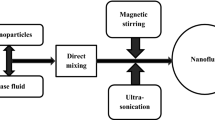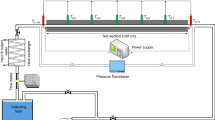Abstract
In the present research work, we investigated the effect of loading mass concentrations (0.05%, 0.15%, and 0.25 mass %) and temperature (10–50 °C) on the thermal properties of graphene oxide-ethylene glycol (GO-EG) nanofluids. A two-step approach was adopted to prepare the GO-EG nanofluids with different mass proportions without any surfactant. The thermal kinetic analysis was performed by modulated DSC and TGA. Thermal stability and particle size distribution of the nanofluids were monitored by using UV–visible spectroscopy and dynamic light scattering. The experimental findings on the thermal transport characteristics of the as-prepared nanofluid samples are influenced by loading mass concentration, increasing temperature because of the high relative area of dispersed nanoparticles at higher particle concentration, dispersion quality of nanofluids. The thermal conductivity (TC) of GO-EG nanofluid shows an enhancement of 36.72% for (sample no. 3, i.e., GO 3) and shows a semi-linear dependence profile between temperature and TC, with increasing mass concentration due to the decrease in interfacial thermal resistance between GO and EG. The observed results are in good agreement with previously reported literature and reveal the promising prospect for usage as a state-of-the-art heat transport fluid in the coolant industry.













Similar content being viewed by others
References
Das SK, Choi SU, Patel HE. Heat transfer in nanofluids—a review. Heat Transf Eng. 2006;27:3–19.
Ijam A, Saidur R, Ganesan P, Golsheikh AM. Stability, thermo-physical properties, and electrical conductivity of graphene oxide-deionized water/ethylene glycol based nanofluid. Int J Heat Mass Transf. 2015;87:92–103.
Choi SU. Nanofluid technology: current status and future research. Argonne National Lab. (ANL), Argonne, IL (United States); 1998.
Sen Gupta S, Manoj Siva V, Krishnan S, Sreeprasad TS, Singh PK, Pradeep T, Das SK. Thermal conductivity enhancement of nanofluids containing graphene nanosheets. J Appl Phys. 2011;110: 084302.
Baby TT, Ramaprabhu S. Investigation of thermal and electrical conductivity of graphene based nanofluids. J Appl Phys. 2010;108: 124308.
Hajjar Z, Rashidi AM, Ghozatloo A. Enhanced thermal conductivities of graphene oxide nanofluids. Int Commun Heat Mass Transf. 2014;57:128–31.
Esfahani MR, Languri EM, Nunna MR. Effect of particle size and viscosity on thermal conductivity enhancement of graphene oxide nanofluid. Int Commun Heat Mass Transf. 2016;76:308–15.
Paulchamy B, Arthi G, Lignesh BD. A simple approach to stepwise synthesis of graphene oxide nanomaterial. J Nanomed Nanotechnol. 2015;6:1.
Barai DP, Bhanvase BA, Sonawane SH. A review on graphene derivatives-based nanofluids: investigation on properties and heat transfer characteristics. Ind Eng Chem Res. 2020;59:10231–77.
Selvam C, Lal DM, Harish S. Thermal conductivity and specific heat capacity of water–ethylene glycol mixture-based nanofluids with graphene nanoplatelets. J Therm Anal Calorim. 2017;129:947–55.
Roohani E, Toghraie D. Heat transfer improvement of antifreeze by changing it to hybrid nanofluid: effects of hybrid magnesium oxide–graphene oxide nanopowders. J Therm Anal Calorim. 2021;8:1–5.
Izadkhah MS, Erfan-Niya H, Heris SZ. Influence of graphene oxide nanosheets on the stability and thermal conductivity of nanofluids. J Therm Anal Calorim. 2019;135:581–95.
Alam SN, Sharma N, Kumar L. Synthesis of graphene oxide (GO) by modified hummers method and its thermal reduction to obtain reduced graphene oxide (rGO). Graphene. 2017;6:1–8.
Hadadian M, Goharshadi EK, Youssefi A. Electrical conductivity, thermal conductivity, and rheological properties of graphene oxide-based nanofluids. J Nanoparticle Res. 2014;16:1–7.
Paul G, Philip J, Raj B, Das PK, Manna I. Synthesis, characterization, and thermal property measurement of nano-Al95Zn05 dispersed nanofluid prepared by a two-step process. Int J Heat Mass Transf. 2011;54:3783–8.
Nath D, Singh F, Das R. X-ray diffraction analysis by Williamson-Hall, Halder-Wagner and size-strain plot methods of CdSe nanoparticles-a comparative study. Mater Chem Phys. 2020;239: 122021.
Sagar P, Srivastava M, Prakash R, Srivastava SK. The fabrication of an MoS2 QD–AuNP modified screen-printed electrode for the improved electrochemical detection of cefixime. Anal Methods. 2020;12:3014–24.
Kumar P, Penta S, Mahapatra SP. Dielectric properties of graphene oxide synthesized by modified hummers’ method from graphite powder. Integr Ferroelectr. 2019;202:41–51.
Hosseinghorbani A, Mozaffarian M, Pazuki G. Application of graphene oxide IoNanofluid as a superior heat transfer fluid in concentrated solar power plants. Int Commun Heat Mass Transf. 2020;111: 104450.
Chen J, Yao B, Li C, Shi G. An improved Hummers method for eco-friendly synthesis of graphene oxide. Carbon. 2013;64:225–9.
Cançado LG, Takai K, Enoki T, Endo M, Kim YA, Mizusaki H, Jorio A, Coelho LN, Magalhaes-Paniago R, Pimenta MA. General equation for the determination of the crystallite size La of nanographite by Raman spectroscopy. Appl Phys Lett. 2006;88: 163106.
Khalili D. Graphene oxide: a promising carbocatalyst for the regioselective thiocyanation of aromatic amines, phenols, anisols and enolizable ketones by hydrogen peroxide/KSCN in water. New J Chem. 2016;40:2547–53.
Kartick B, Srivastava SK. Green synthesis of graphene. J Nanosci Nanotechnol. 2013;13:4320–4.
Kumar N, Das S, Bernhard C, Varma GD. Effect of graphene oxide doping on superconducting properties of bulk MgB2. Supercond Sci Technol. 2013;26: 095008.
Mageed AK, Ab DR, Salmiaton A, Izhar S, Razak MA, Yusoff H, Yasin F, Kamarudin S. Preparation and characterization of nitrogen doped reduced graphene oxide sheet. Int J Appl Chem. 2016;12:104–8.
Kumar R, Sinha N, Kumar B. Influence of xylenol orange dye on structural, vibrational, thermal and luminescence properties of TGS crystals. J Mater Sci Mater Electron. 2021;32:2486–504.
Ghozatloo A, Rashidi A, Shariaty-Niassar M. Convective heat transfer enhancement of graphene nanofluids in shell and tube heat exchanger. Exp Therm Fluid Sci. 2014;53:136–41.
Selvam C, Lal DM, Harish S. Thermal conductivity enhancement of ethylene glycol and water with graphene nanoplatelets. Thermochim Acta. 2016;642:32–8.
Ahmed W, Kazi SN, Chowdhury ZZ, Johan MR, Mehmood S, Soudagar ME, Mujtaba MA, Gul M, Ahmad MS. Heat transfer growth of sonochemically synthesized novel mixed metal oxide ZnO+Al2O3+ TiO2/DW based ternary hybrid nanofluids in a square flow conduit. Renew Sust Energ Rev. 2021;145: 111025.
Rostami S, Nadooshan AA, Raisi A. An experimental study on the thermal conductivity of new antifreeze containing copper oxide and graphene oxide nano-additives. Powder Technol. 2019;345:658–67.
Yu X, Wu Q, Zhang H, Zeng G, Li W, Qian Y, Li Y, Yang G, Chen M. Investigation on synthesis, stability, and thermal conductivity properties of water-based SnO2/reduced graphene oxide nanofluids. Materials. 2018;11:38.
Maheshwary PB, Handa CC, Nemade KR. A comprehensive study of effect of concentration, particle size and particle shape on thermal conductivity of titania/water based nanofluid. Appl Therm Eng. 2017;119:79–88.
Keblinski P, Phillpot SR, Choi SU, Eastman JA. Mechanisms of heat flow in suspensions of nano-sized particles (nanofluids). Int J Heat Mass Transf. 2002;45:855–63.
Evans W, Fish J, Keblinski P. Role of Brownian motion hydrodynamics on nanofluid thermal conductivity. Appl Phys Lett. 2006;88: 093116.
Mehrali M, Sadeghinezhad E, Rosen MA, Latibari ST, Mehrali M, Metselaar HS, Kazi SN. Effect of specific surface area on convective heat transfer of graphene nanoplatelet aqueous nanofluids. Exp Therm Fluid Sci. 2015;68:100–8.
Patel HE, Sundararajan T, Das SK. An experimental investigation into the thermal conductivity enhancement in oxide and metallic nanofluids. J Nanoparticle Res. 2010;12:1015–31.
Esfe MH, Saedodin S, Wongwises S, Toghraie D. An experimental study on the effect of diameter on thermal conductivity and dynamic viscosity of Fe/water nanofluids. J Therm Anal Calorim. 2015;119:1817–24.
Acknowledgements
The author Sachin Kumar Yadav duly acknowledges the University Grant Commission (UGC), New Delhi, for financial support. The authors would also like to extend his appreciation to Mr. Pushpesh Pathak Research Fellow (IIT Guwahati), Mr. Tarun Katheriya, and Gurudeo Nirala Research Fellow (IIT BHU) and Prof. Raja Ram Yadav, (UGC Centre of Advanced Studies) Department of Physics, University of Allahabad, for experimental facilities. Authors also convey their thanks to Dr. Navneet Yadav, University of Allahabad for discussion.
Author information
Authors and Affiliations
Contributions
S.K.Y. contributed to writing the complete manuscript, experimental characterizations of synthesized graphene oxide, analysis of the experimental parts in the manuscript. D.R. contributed to synthesis of grapheme oxide, design the experimental process to synthesize graphene oxide, checking the manuscript writing. A.K.Y., the corresponding author, contributed to the supervision of the whole research work, writing the manuscript. P.S. contributed to experimental characterizations of the synthesized graphene oxide. S.K.A. gave valuable discussions to analyze the experimental data, checking the manuscript.
Corresponding author
Ethics declarations
Conflicts of interest
There are no conflicts to declare.
Additional information
Publisher's Note
Springer Nature remains neutral with regard to jurisdictional claims in published maps and institutional affiliations.
Rights and permissions
About this article
Cite this article
Yadav, S.K., Roy, D., Yadav, A.K. et al. Synthesis and characterization of graphene oxide-based nanofluids and study of their thermal conductivity. J Therm Anal Calorim 147, 11661–11670 (2022). https://doi.org/10.1007/s10973-022-11388-3
Received:
Accepted:
Published:
Issue Date:
DOI: https://doi.org/10.1007/s10973-022-11388-3




